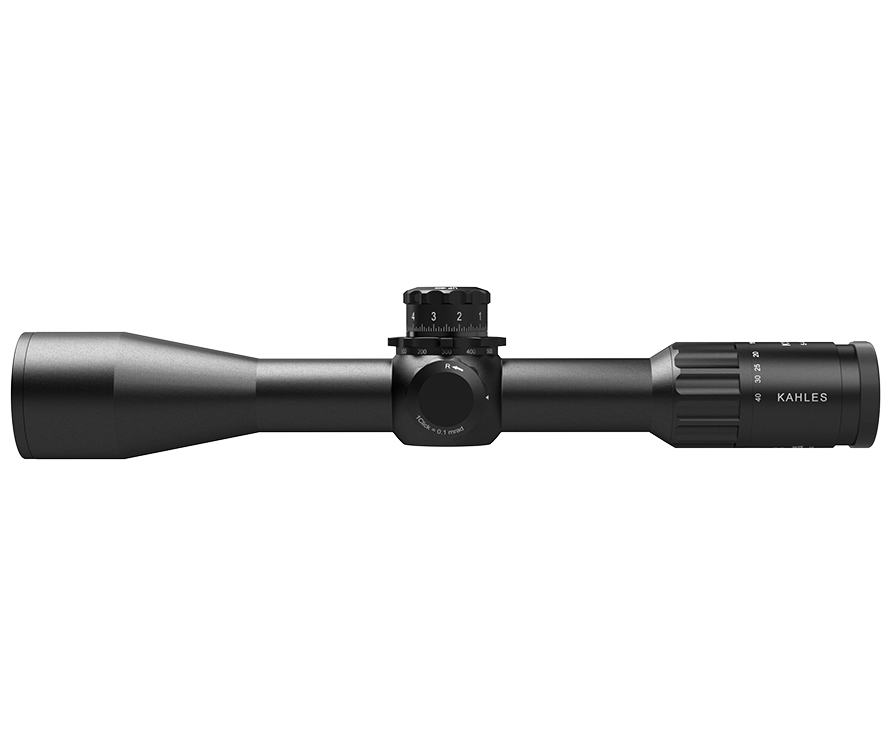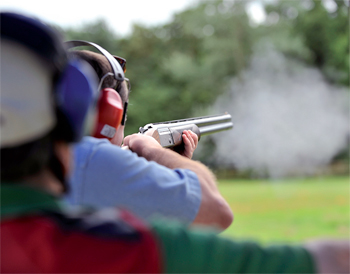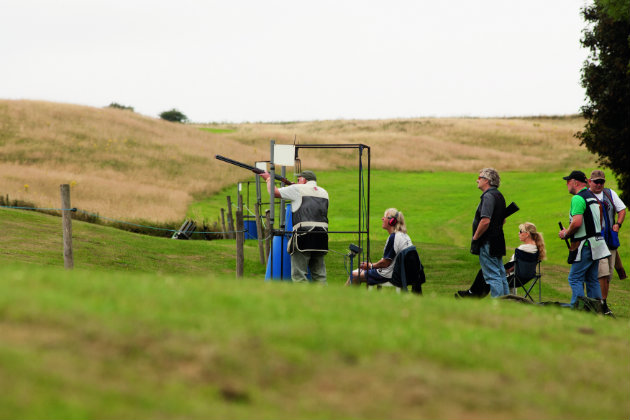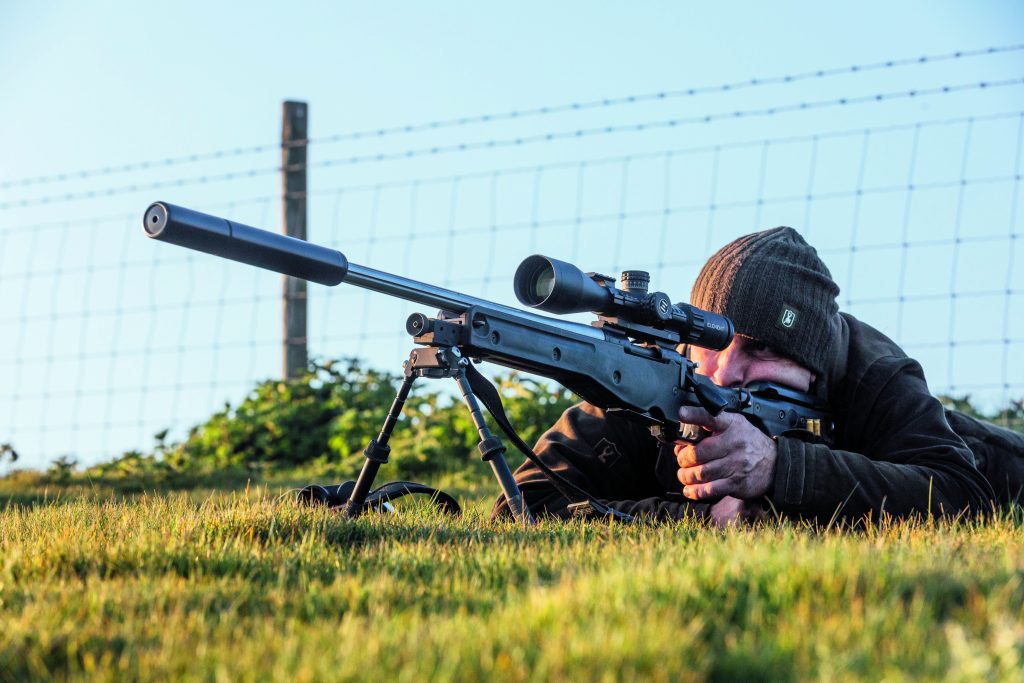Clay shooting: Are clay shooting lessons good practice for the game shooting season, when driven quarry accelerates towards the gun,…
News
Want to be a better Shot?
Would you like to speak to our readers? We offer sponsored articles and advertising to put you in front of our audience. Find out more.
A couple of months ago I floated the suggestion that even a small bit of preparation for the game and wildfowling season might result in a more successful first day out on partridges, pheasants or the flightpond.
Doubtless pressure of time has again stymied your best intentions to shoot some clays and to practise those high-incomers and longer crossers in readiness for the big day. So what can be done at this late stage?
For some of you it could be nearly nine months since your last outing with a gun and that is a considerable gap in terms of practice for a challenging sport involving hand and eye co-ordination.
Dry-mounting practice
However, all is not lost. Draw the curtains in the living room or hallway and re-awaken your muscle memory with the gun by doing a daily stint of dry-mounting practice. Why draw the curtains? Well, you wouldn’t want the armed-response team round from the constabulary do we!
Oh, and to be absolutely clear here, there are no cartridges involved in this simulated practice.
Objectives when dry-mounting
What we are trying to do by dry-mounting the gun in the comfort of our own home falls into three basic activities:
- Rehearsing the perfect position of the stock on our cheek when the gun is fully mounted and ready to fire.
- Building up the muscle memory in our hands, arms and chest, which enables the gun to move reliably and consistently – all the way from the relaxed gun-down waiting posture to the position at our shoulder where the stock is correctly in your cheek.
- To practise the all-important foot movement and upper-body movement required when taking targets to the left and right at higher and lower elevations. This includes addressing the straight overhead true driven target.
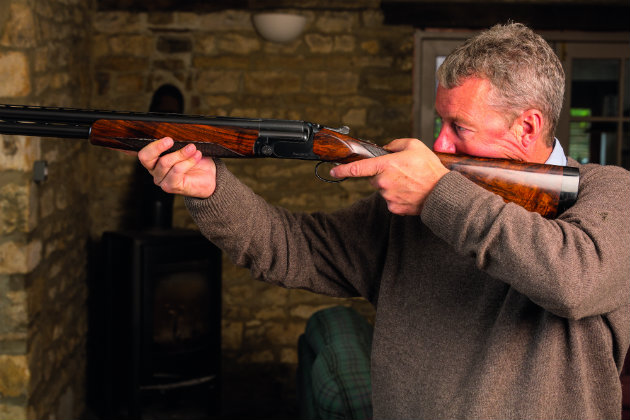
The eye controlling the gun should be over the centre of the rib of the gun
Now close your eyes
No matter what type of shooting you do, it’s essential that the gun you use should point where you are looking. This means that a correctly mounted gun will be positioned in your cheek so that your line of sight is just grazing the top of the rib of the gun. In this position you will see all the foresight of the gun and you may just perceive the length of the top rib stretching away as a black footpath. Any hint of looking down on the top of the rib indicates that your eye is too high.
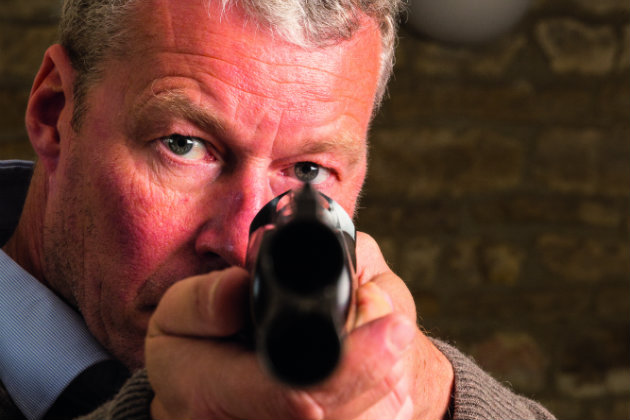
A coach can help if you find a dominant eye is affecting the direction of the gun
If you con’t consider cheek/eye placement that important, think again. For every 1/8in that your eye is too high, the placement of the shot pattern at 40 yards will move approximately one foot too high as a result.
- Mount the gun to your cheek with your eyes closed. Start with the gun just a few inches from your cheek, rather than fully demounted in the relaxed but ready position.
- Open your eyes and check that the eye controlling the gun (for example, right-handed, right shoulder, right eye) is directly over the centre of the rib of the gun and that the elevation of your eye is as described earlier.
- If the gun is not in the correct position, readjust it in your cheek with both eyes open and remember the touch position on your cheek for the perfect gun mount.
- De-mount the gun, close your eyes and try for the perfect cheek position.
If you hit the right cheek position, demount and repeat. Continue the repetition until you no longer have to think about the activity at all; you must get to the state where you know the gun is correct at your cheek. Only then can you turn your brain 100 per cent to target concentration.
If, for some reason, you cannot achieve a reliable and consistent cheek position by mounting the gun in this way, there may be something wrong with your gun fit and it would be a good idea to see a coach.
A test with a mirror
I have discussed eye dominance previously, but while on the topic of indoor practice it may be worth mentioning a useful basic dry-mounting test that can be done facing a mirror.
With both eyes open, mount the gun facing the mirror, so that you are attempting to place the shot on your eye over the rib of the gun. For example, for the right-hander/right shoulder shooter, place the shot at your right eye.
If there is any directional contribution from a strongly or partially dominant left eye, the gun will not be pointing absolutely full on to the right eye; it might be pointing to the left eye or may be at your nose.
If you see these symptoms, I would strongly suggest seeing a coach who will investigate the phenomenon with both dry-mounting and live firing sessions.
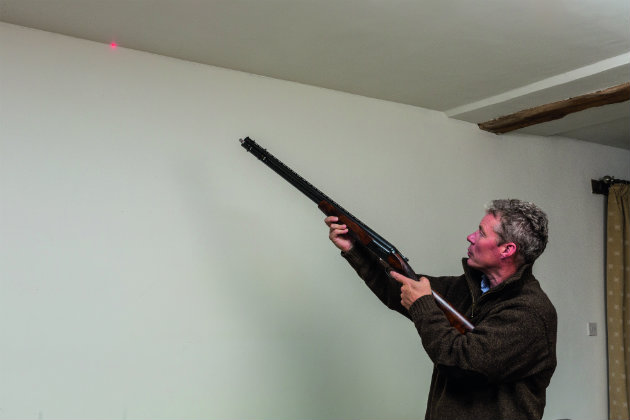
Imagine that where the ceiling and wall meet is the line of a crossing target. Keep the gun moving along the imaginary flight line of the target.
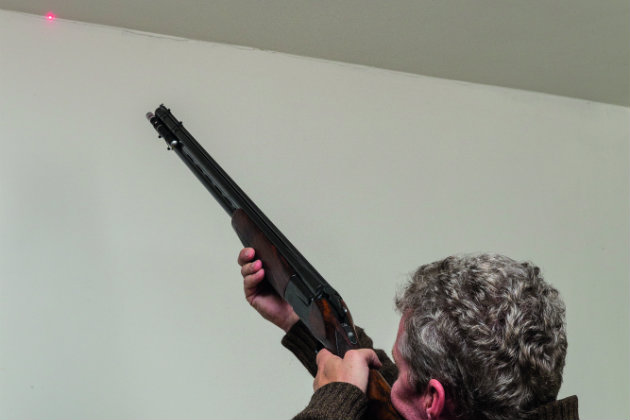
Both the leading hand and trigger hand should move in unison to bring the gun to your cheek and then swing the gun to add forward allowance
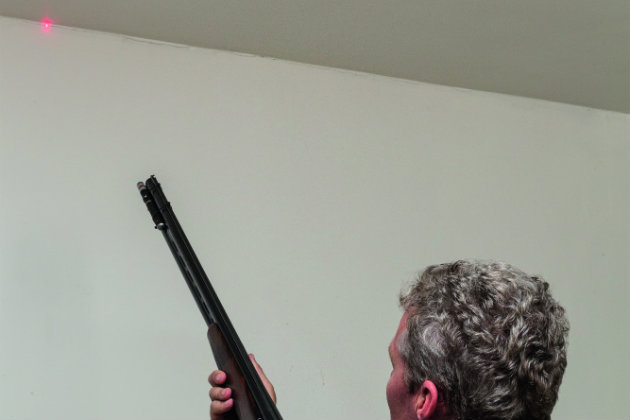
Parallel gun mount is about keeping the gun on target whether for crossers or driven targets
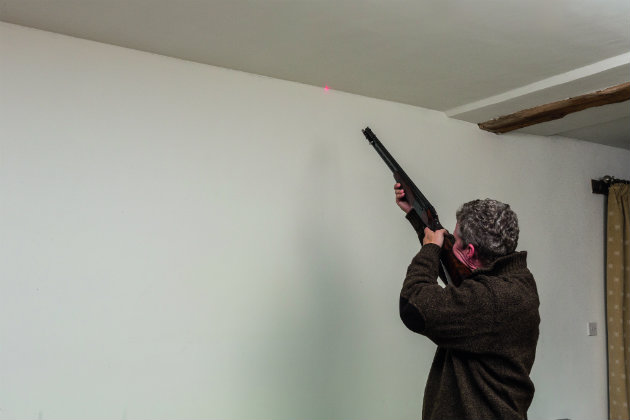
Mount the gun in one smooth movement. Do this in slow motion to build up muscle memory.
Tone muscles with a laser
You can do this exercise with an imaginary laser, or a real one. The exercise with a real one is actually quite revealing and you can buy one for very little expense. Some fit in the muzzle of your barrel, in the chamber of the gun like a cartridge, or simply attach to the side of the barrel with an elastic belt.
Before lasers were invented, coaches used to suggest the analogy of a high-pressure water jet coming out of the gun muzzles. Admittedly, this was rather messy in practice if you did it in the house, but nowadays this presents no problem when using a laser.
- Imagine a crossing target flying along the line created where the wall and the ceiling meet. You identify where you can first see the imaginary pheasant on the line; you can point the laser at the target even when the gun is at waist height in the ready position. That is just like hose-piping an object with the pipe held at waist height.
- As you mount the gun to your cheek, keep the laser spot pointing at the ceiling line, as the imaginary pheasant flies along the same path. Achieving this movement will require both arms to work in absolute unison. There should be no hint of the trigger hand moving first, trying to get the gun to the shoulder; if that happens the laser spot will rapidly pull down the wall, away from the target.
More gun movement is less
The optimum gun movement is actually the minimum gun movement; the laser stays close to the target during the whole process of getting the gun to your cheek.
It is all one unified, steady movement of the gun with both arms keeping the laser on the target, while the gun moves to your cheek. Coaches call this the parallel gun mount because both hands are travelling vertically together to get the stock to the touch-point on your cheek, while keeping the laser pointing out the target at the same time.
- When the gun touches your cheek, put on the lead or forward allowance and, with snap caps in the gun, pull the trigger.
- Practise right to left crossers and left-to-right crossers; if you practise in slightly slow motion, you will notice your muscles getting tired after very few repetitions. The muscles are remembering what the movement feels like.
- You can also introduce foot movement by facing the “wrong way”, so that you have to partially turn to get the laser onto the imaginary target.
- For true-driven targets, use a path down the centre of the ceiling, straight over your head.
Dry mounting can never replace the benefits of shooting some sporting clays before a day on live game, but what it does do, at least, is give you a very useful pre-season warm up.
And the neighbours won’t have heard a thing…
Dr Malcolm Plant is Chairman of the Institute of Clay Pigeon Shooting Instructors and a Clay Pigeon Shooting Association senior coach.
Clayshooting lesson – high, slow-driven clays
Sean Ponting of Widdington Shoot has pretty much been there and got the T-shirt as far as Sporting and FITASC clayshooting goes. He has had 20 years…
Related articles
News
Anti-grouse shooting petition crushed by MPs who don't even shoot
Wild Justice's petition to ban driven grouse shooting was quashed in Westminster Hall yesterday, with all but one MP opposing the ban
By Time Well Spent
News
A sound decision as moderators to be taken off licences
The Government has finally confirmed what the shooting community has long argued – that sound moderators should be removed from firearms licensing controls
By Time Well Spent
Manage Consent
To provide the best experiences, we use technologies like cookies to store and/or access device information. Consenting to these technologies will allow us to process data such as browsing behavior or unique IDs on this site. Not consenting or withdrawing consent, may adversely affect certain features and functions.
Functional Always active
The technical storage or access is strictly necessary for the legitimate purpose of enabling the use of a specific service explicitly requested by the subscriber or user, or for the sole purpose of carrying out the transmission of a communication over an electronic communications network.
Preferences
The technical storage or access is necessary for the legitimate purpose of storing preferences that are not requested by the subscriber or user.
Statistics
The technical storage or access that is used exclusively for statistical purposes.
The technical storage or access that is used exclusively for anonymous statistical purposes. Without a subpoena, voluntary compliance on the part of your Internet Service Provider, or additional records from a third party, information stored or retrieved for this purpose alone cannot usually be used to identify you.
Marketing
The technical storage or access is required to create user profiles to send advertising, or to track the user on a website or across several websites for similar marketing purposes.


